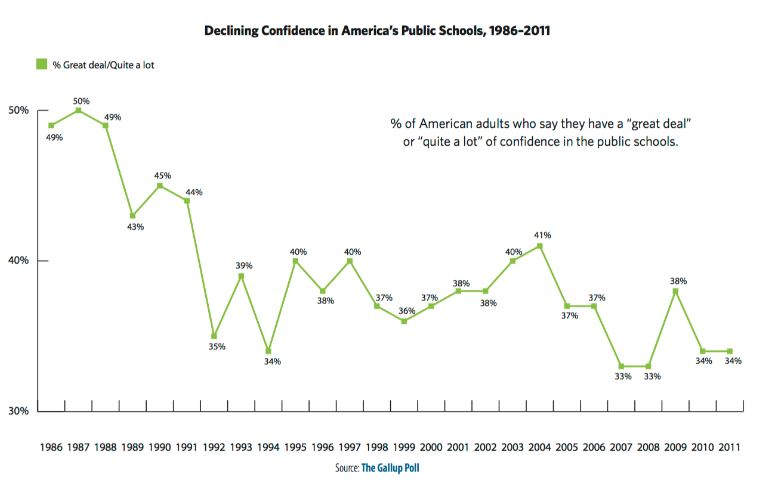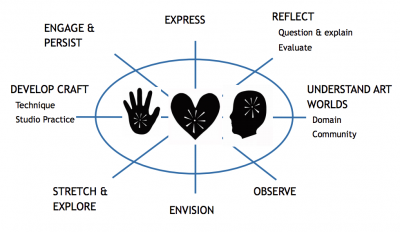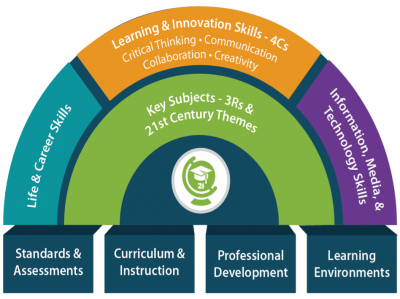Introduction:
This website is designed as a resource guide on the topic of museum-school partnerships. The focus of the project is specifically on the relationship between visual arts museums and public schools that follow, a multiple engagement structure and has programming both within the school and at the museum.
These partnerships are a true collaboration, where the museum and school create a mutually beneficial program that achieves success for both organizations. According to museum educators Kim Fortney and Beverly Sheppard:
When museums and schools work together on setting goals and asking questions, they raise the odds for a successful experience.1
Museum Education and Museum-School Partnerships:
Museums, specifically non-profit art museums, are institutions that serve the public good. While education programming has long been a priority for many of these organizations, the development, and implementation of long-term partnerships with area schools is relatively new. In 2012 the American Association/Alliance of Museums (AAM) published their annual Trendswatch, in which they identified as one of the emerging trends a shift towards non-traditional forms of education in the United States school system.2
This trend—which AAM identifies as a “New Education Era”—takes its starting point from a report published by The Gallup Poll in 2011 on the decline of confidence of in American public-school system.3

The report shows a steady decrease in the percentage of American adults who have a “great deal” of confidence in public schools, from a peak of 50% in 1987 to the current reported low of 34% in 2011. This decline in confidence has led to a change in the current form of “industrialized learning,” in which education is formalized and characterized by classroom instruction, age-cohorts, and a core curriculum. As learning moves away from this traditional format, new platforms for learning are becoming increasingly prevalent and are creating opportunities for cultural organizations to become part of a new education framework. According to Trendswatch:
The U.S. needs to scale up the educational resources and skills provided by its museums via online access, better indexing of online resources, physically incorporating museums into schools and schools into museums, and making museums central points for teacher training.
This decline in confidence coupled with the instability of funding in the public school system, where cuts in educational support at the local, state and federal level has resulted in 29 states with significantly lower budgets than they had 10 years ago, has pushed the United States towards this hybrid system identified in the 2012 Trendswatch.5
While the National Common Core Standards are still in place, on the local level many schools are starting to embrace non-traditional teaching. Since education departments still need to maintain the Common Core community and cultural organization have stepped up and created programming that fulfills teachers and students need for creative outside the classroom learning experiences.
Though many museums still follow the traditional field trip model, there are more and more that have implemented in-depth, long-term programming. Museums are partnering with schools in order to create custom programming for their students that both follows the Common Core and provides cross-disciplinary learning in a non-traditional setting.
The partnership takes on new significance as our society expands its definition of “education” to describe a lifelong process of developing knowledge, skills, and character that takes place not just in the classroom, but in a variety of formal and informal settings. Museums and schools both figure in this learning network and they have long worked together toward common educational goals.6
These programs extend beyond the standards outlined in the Common Core to incorporate skills that have been identified as crucial for students’ future success, such as visual literacy, critical thinking, creativity, and collaboration. Many of these partnerships incorporate one or more of the following pedagogical methods.
Visual Thinking Strategies:7
Visual Thinking Strategies (VTS) is an inquiry-based teaching method founded by psychologist Abigail House and museum educator Philip Yenawine.
The main aspects of VTS teaching practice include three key inquiries:
1. What's going on in this picture?
2. What do you see that makes you say that?
3. What more can we find?
Museums are teaching this technique to teachers and it has been incorporated into many school's curricula and teaching methods.
“VTS is much more than an art curriculum; as a facilitation method and professional development program that fosters a collaborative, inclusive, community-building dialogue, ... VTS is uniquely suited to support educators as they rise to meet the challenges and opportunities of 21st-century education.”8
Studio Thinking Framework:9
The Studio Thinking Learning Framework came out of a study conducted by the Harvard Graduate School of Education’s Project Zero. This study looked at the habits of mind taught in visual arts classes, and classroom structures that facilitate this learning.
This study resulted in a framework that combined two components, the Studio Habits of Mind and Studio Structures.
The Studio Habits of Mind describe eight dispositions students are taught so that they learn to think like artists. The Studio Structures are ways for teachers to organize time, space, and interactions in visual arts classrooms.10

The four Studio Structures (Demonstration-Lectures, Students-at-Work, Critique, and Exhibition) describe how teachers shape classroom instruction to focus on the thinking involved in creating.11
The Studio Thinking Learning Framework has been revised twice over the years first in 2013 with an expanded version and again in 2018 to include elementary and middle school levels.12
21st Century Learning:
21st Century was developed by the Partnership for 21st Century Learning (P21) in 2013. Since then P21 has annually designated a school or school district as an exemplar program that has fully integrated 21st Century Learning into their curriculum.
P21's Framework for 21st Century Learning was developed with input from teachers, education experts, and business leaders to define and illustrate the skills and knowledge students need to succeed in work, life, and citizenship, as well as the support systems necessary for 21st-century learning outcomes. It has been used by thousands of educators and hundreds of schools in the U.S. and abroad to put 21st-century skills at the center of learning.13
P21’s learning framework focuses on the following skill areas -
- Key Subjects and 21st Century Themes
- Examples - Global Warming and Civic Literacy
- Learning and Innovation Skills
- Information, Media and Technology Skills
- Life and Career Skills

Building on the pedagogical method established by P21, the Institute of Museum and Library Services (IMLS) has developed its own version of 21st Century Skills for use in museums and libraries.
Success in today’s society requires information literacy, a spirit of self-reliance, and a strong ability to collaborate, communicate effectively, and solve problems. Combining strengths in traditional learning with robust investment in modern communication infrastructures, libraries and museums are well-equipped to build the skills Americans need in the 21st century.14
The skills that the IMLS focuses on are as follows. 15
- Critical Thinking and Innovation
- Communication and Collaboration
- Visual Literacy
- Scientific and Numerical Literacy
- Cross-Disciplinary Thinking
- Information, Media and Technology
- 21st Century Themes
- Initiative and Self-Direction
- Social and Cross-Cultural Skills
- Productivity and Accountability
- Leadership and Responsibility
It is these pedagogical methods that make museum-school partners successful. Museums are able to enhance the Common Core by focusing on valuable personal and civic skills that many schools do not have the resources to provide.
1 Kim Fortney and Beverly Sheppard, An Alliance of Spirit: Museum and School Partnerships. (Washington, DC: American Alliance of Museums, 2010)
2 Elizabeth Merritt, et al. “Trendswatch 2012: Museums and the Pulse of the Future,” American Association of Museums, 2012.
3 Lymari Marales, “New Record-Low Confidence in US Public Schools,” Gallup, 2011.
4 Merritt, “Trendswatch 2012: Museums and the Pulse of the Future.”
5 Michael Lachman, et al. "A Punishing Decade for School Funding," Center on Budget and Policy Priorities, 2017.
6 Ellen Cochran Hicks, “Museums and Schools as Partners,” (ERIC Clearinghouse on Information Resources, 1986.)
7 "Visual Thinking Strategies," accessed April 22, 2019, https://vtshome.org/
8 "Visual Thinking Strategies: About," accessed April 22, 2019, https://vtshome.org/about/
9 "Project Zero: Studio Thinking Project," accessed April 22, 2019, http://www.pz.harvard.edu/projects/the-studio-thinking-project
10 "Project Zero: Eight Habits of Mind," accessed April 22, 2019, http://www.pz.harvard.edu/resources/eight-habits-of-mind
11 "Project Zero: Four Studio Structures," Accessed April 22, 2019, http://www.pz.harvard.edu/resources/four-studio-structures
12 "Studio Thinking," accessed April 22, 2019, http://www.studiothinking.org/the-framework.html
13 "Battle for Kids: Frameworks Resources," accessed April 23, 2019, http://www.battelleforkids.org/networks/p21/frameworks-resources
14 "Institute of Museum and Library Services: 21st Century Skills," accessed April 23, 2019, https://www.imls.gov/issues/national-initiatives/museums-libraries-and-21st-century-skills
15 "Institute of Museum and Library Services: 21st Century Skills Definitions," accessed April 23, 2019, https://www.imls.gov/issues/national-initiatives/museums-libraries-and-21st-century-skills/definitions